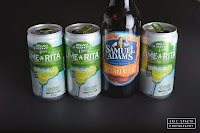Time for another assignment. This time we are talking about apparent light size, also referred to as "softness". What's the point? It all affects the look and feel of an image. Lights that very small (relative to the subject) give very sharp, crisp edges. This tends to give an image a much different feel than if that same subject were lit using the same AMOUNT of light, but it was coming from a much bigger area. Think of a stage, an actor could be lit with a spotlight (sharp, directional), or you could turn on the lights in the theater (soft, omnidirectional).
For my subject, I opted against the recommended piece of fruit (...or just forgot that it was the suggested subject) and went with a small figurine I obtained from a vacation in Mexico. I lit it in four different ways, increasing the apparent light size each time.
1) Bare Flash from ~8 feet (size: point source)
2) Flash with a single sheet of printer paper bent around the front from 8 feet (size: a few sq. inches)
3) Flash behind a curtain draped over my arm from 8 feet (size: 1-2 sq. feet)
4) Bare Flash at 8 feet pointed away from subject at corner of the room (size: many sq. feet)
I adjusted the aperture (and ISO in the case of the wall bounce) to get similar exposure based on the histogram, since the various ad hoc diffusers would eat some unknown amount of flash power. Only in the wall bounce picture did a very small amount of ambient begin to leak in as indicated by a no-flash image. Here's the results.
The first thing I noticed was not related to softness, but rather the color shift that occurred with the diffusers. All pictures were taken on flash white balance, but clearly the diffusers are shifting that warmer, which makes sense, since none of them are pure white, and in the case of the walls, beige.
The bare flash clearly gives the sharpest shadows, even to the point of showing the texture of the printer paper beneath the figurine. Whereas the wall bounce flash is difficult to even detect the shadow.
Overall, softness looks very useful for adjusting the overall emotion or feel that an image elicits.
Link to Strobist Blog Post for this Assignment
 For my subject today, I chose a few empty beverage containers that happened to be lying around my desk. One being glass is highly reflective, the other 3 being printed aluminum have less reflection. I wanted, with my limited resources to have a vertical, lengthwise reflection for the primary source, so I bounced my Auto128 flash from behind the cans to the right, onto a large white sheet of foamcore. This turned my flash into a 30"x40" rectangular light source, which also helped to minimize the shadows on the background. In addition, I provided a bit of fill from the left with a couple sheets of copy paper.
For my subject today, I chose a few empty beverage containers that happened to be lying around my desk. One being glass is highly reflective, the other 3 being printed aluminum have less reflection. I wanted, with my limited resources to have a vertical, lengthwise reflection for the primary source, so I bounced my Auto128 flash from behind the cans to the right, onto a large white sheet of foamcore. This turned my flash into a 30"x40" rectangular light source, which also helped to minimize the shadows on the background. In addition, I provided a bit of fill from the left with a couple sheets of copy paper.

